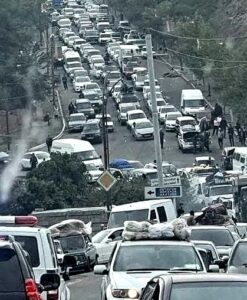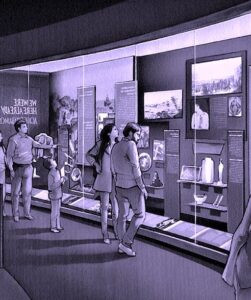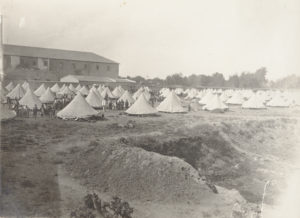Civil Liberties, Civil Rights, genocide, Human Rights
Podcast: Play in new window | Download


Tens of Thousands Of Armenians Forced To Flee Their Homes
Two weeks ago, the small mountainous Republic of Artsakh was vanquished by Azeri military forces. It happened with such haste that thousands of its predominantly ethnic Armenian population had just minutes to abandon their homes.. This followed on the heels of an Azerbaijani blockade that left Armenians without food, fuel, and medicine. Artsakh has been the site of a decades-long protracted battle between Muslim and Turkish Azerbaijanis and Christian Armenians. The conflict began when Armenia and Azerbaijan were under Soviet rule. After both nations gained independence, the conflict escalated into full scale war. That war ended in 1994, with an independent Artsakh, the Armenian name for Nagorno-Karabakh, and Armenia in control of a wide swath of Azerbaijan.
Unverified reports of mass killings and rape roused fears of a repeat of the 1915 Armenian genocide by the Ottoman Empire. The first genocide of the 20th century, it was the systematic destruction of the Armenian people and identity during World War I. The genocide ended more than 2,000 years of Armenian civilization in eastern Anatolia. Along with the mass murder of Assyrian/Syriac and Greek Orthodox Christians, it enabled the creation of the Republic of Turkey. While the Turkish government denies the slaughter of Armenians was genocide, as of 2023, 34 countries have recognized the events as such.
Guest – Alex Galitsky is the Programs Director at the Armenian National Committee of America. Alex’s opinions and analysis have been published in major media outlets, including Newsweek, the Los Angeles Times, Foreign Policy, and The Hill. He has worked at the local, state, and federal levels to advance policy and legislation to protect the rights of the Armenian people nationally and internationally. ANCA Action Center
—-


National Museum of the American Latino Controversy
In 2020, Congress appropriated funding to create a National Museum of the American Latino. Last year, the Smithsonian Institution opened a temporary preview exhibition inside the National Museum of American History. The show was slated to be the largest federally funded Smithsonian exhibit on Latino civil rights history. The nation’s top Latino historians and veterans of the movement gave input. It was to feature student walkouts, school integration initiatives, and environmental and immigration activism.
Instead, it has become the focus of controversy within the Latino community over how Latinos in the United States should be portrayed. The Smithsonian has nixed the show; in its place will be an exhibit on salsa and Latin music.
That’s because Republican lawmakers and others challenge what one conservative writer described last year in The Hill as an “unabashedly Marxist portrayal of history.” Right-wing Latino political activists and Cuban-American politicians like Florida Congressman Mario Diaz-Balart voted to defund the museum.
The controversy comes as the Smithsonian is trying to raise funds to build the museum at estimated $800 million. Of this, $58 million has been raised to date.
Two historians were hired to develop the exhibit on the Latino civil rights movement of the 1960s for the museum. Felipe Hinojosa a history professor at Baylor University in Texas and Johanna Fernández, the associate professor of history at the City University of New York’s Baruch College.
Guest – Professor Felipe Hinojosa is the author of Apostles of Change: Latino Radical Politics, Church Occupations, and the Fight to Save the Barrio. His research areas include Chicana/o and Latina/o Studies, American Religion, Race and Ethnicity, and Social Movements. Prof. Hinojosa serves on the Advisory Board for the interdisciplinary, peer-reviewed, and online moderated forum Latinx Talk.
Hosted by attorney Heidi Boghosian

———————————————————
genocide, Human Rights, Human Trafficking, Truth to Power, War Resister
Podcast: Play in new window | Download


It Was Genocide: Armenian Survivor Stories
Around the world, April 24 marks the observance of the Armenian Genocide. On that day in 1915 the Interior Minister of the Ottoman Empire ordered the arrest and hangings of Armenian intellectuals and community leaders in Constantinople. It was the beginning of a systematic and well-documented plan to eliminate the Armenians, who were Christian, and who had been under Ottoman rule and treated as second class citizens since the 15th century.
The unspeakable and gruesome nature of the killings—beheadings of groups of babies, dismemberments, mass burnings, mass drownings, use of toxic gas, lethal injections of morphine or injections with the blood of typhoid fever patients—render oral histories particularly difficult for survivors of the victims.
Why did this happen? Despite being deemed inferior to Turkish Muslims, the Armenian community had attained a prestigious position in the Ottoman Empire and the central authorities there grew apprehensive of their power and longing for a homeland. The concerted plan of deportation and extermination was effected, in large part, because World War I demanded the involvement and concern of potential allied countries. As the writer Grigoris Balakian wrote, the war provided the Turkish government “their sole opportunity, one unprecedented” to exploit the chaos of war in order to carry out their extermination plan.
As Armenians escaped to several countries, including the United States, a number came to New Britain, Connecticut in 1892 to work in the factories of what was then known as the hardware capital of the world. By 1940 nearly 3,000 Armenians lived there in a tight-knit community.
Pope Frances calls it a duty not to forget “the senseless slaughter” of an estimated one and a half million Armenians by the Ottoman Turks from 1915 to 1923. “Concealing or denying evil is like allowing a wound to keep bleeding without bandaging it,” the Pope said just two weeks before the 100th anniversary of the systematic implementation of a plan to exterminate the Armenian race.
Special thanks to Jennie Garabedian, Arthur Sheverdian, Ruth Swisher, Harry Mazadoorian, and Roxie Maljanian. Produced and written by Heidi Boghosian and Geoff Brady.

—————————————–
genocide, Human Rights, Torture, Violations of U.S. and International Law
Podcast: Play in new window | Download


Radio Documentary – It Was Genocide: Armenian Survivor Stories
Around the world, April 24 marks the observance of the Armenian Genocide. On that day in 1915 the Interior Minister of the Ottoman Empire ordered the arrest and hangings of Armenian intellectuals and community leaders in Constantinople. It was the beginning of a systematic and well-documented plan to eliminate the Armenians, who were Christian, and who had been under Ottoman rule and treated as second class citizens since the 15th century.
The unspeakable and gruesome nature of the killings—beheadings of groups of babies, dismemberments, mass burnings, mass drownings, use of toxic gas, lethal injections of morphine or injections with the blood of typhoid fever patients—render oral histories particularly difficult for survivors of the victims.
Why did this happen? Despite being deemed inferior to Turkish Muslims, the Armenian community had attained a prestigious position in the Ottoman Empire and the central authorities there grew apprehensive of their power and longing for a homeland. The concerted plan of deportation and extermination was effected, in large part, because World War I demanded the involvement and concern of potential allied countries. As the writer Grigoris Balakian wrote, the war provided the Turkish government “their sole opportunity, one unprecedented” to exploit the chaos of war in order to carry out their extermination plan.
As Armenians escaped to several countries, including the United States, a number came to New Britain, Connecticut in 1892 to work in the factories of what was then known as the hardware capital of the world. By 1940 nearly 3,000 Armenians lived there in a tight-knit community.
Pope Frances calls it a duty not to forget “the senseless slaughter” of an estimated one and a half million Armenians by the Ottoman Turks from 1915 to 1923. “Concealing or denying evil is like allowing a wound to keep bleeding without bandaging it,” the Pope said just two weeks before the 100th anniversary of the systematic implementation of a plan to exterminate the Armenian race.
Special thanks to Jennie Garabedian, Arthur Sheverdian, Ruth Swisher, Harry Mazadoorian, and Roxie Maljanian. Produced and written by Heidi Boghosian and Geoff Brady.
—-


Horrors Of Adana by Bedross Der Matossian
In April 1909, a few years before the 1914 Ottoman massacre of Armenians, two massacres killed more than 20,000 Christians, primarily Armenians. They transpired in Adana, situated on the Mediterranean cost of southern Anatolia. Images of the area after the attacks show unprecedented destruction of a formerly prosperous city. Armenian churches, businesses, and homes were destroyed, and the violence quickly spread across the province and extended outside its eastern borders into the province of Aleppo.
Despite the magnitude of these devastating atrocities, no one was held accountable. In fact, they have have remained largely absent from history books. But that’s about to change.
Guest – Bedross Der Matossian has written a meticulously-researched examination of these events. It’s called The Horrors of Adana: Revolution and Violence in the Early Twentieth Century, and it’s published by Stanford University Press. It’s a detailed exploration of the twin massacres and the events and the economic and sociopolitical transformations leading up to them. He is Associate Professor at the University of Nebraska, Lincoln, and the president of the Society for Armenian Studies. He is the author and co-editor of several books including the award-winning book, Shattered Dreams of Revolution: From Liberty to Violence in the Late Ottoman Empire.

——————————-








